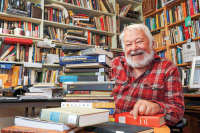A little surer, a little more lost
I can’t help feeling, just slightly, like we cheated. You be the judge.
The table had been set on our recent family vacation for a trip unlike any I’d ever experienced. We had planned a four-night sailing trip on my father-in-law’s 32-foot sloop “Tranquilo.” My wife Lori and I may joke around at home about who wears the pants, but on the boat there’s no doubt — she dons the captain’s hat. She has sailed for years with her father in the waters around the Neuse River and Pamlico Sound, so he trusts her to get his beloved boat back to its slip safely while we — the kids and I — are the benefactors of a great time.
When we had planned the trip, it was to be an educational jaunt. We would mosey around the Pamlico Sound and up to the waters of the Albemarle, visiting some of North Carolina’s historic coastal communities and researching their history, munching on seafood at night and doing gallant battle with the incessant mosquitoes.
But that plan never got off the ground, or, should I say, out of the dock. The trip was cut short a few days due to other obligations. The overpowering heat wave that spread out over the entire Eastern Seaboard convinced us to stay away from the narrow channels where we would often have to be traveling under motor (which means little wind to cool things down).
Instead, Lori proposed a trip to Ocracoke on the Outer Banks, a trip she had often taken with her father but never without him. If memory serves, it’s 44 miles from Oriental to the anchorage, and the course takes you across the widest part of the Pamlico Sound.
Maximum depths across the sound are just over 20 feet, but here’s what totally enthralled me about making the trip — for three or four hours, the boat was out of sight of land. We would be navigating according to charted routes and the compass. If winds died or a thunderstorm blew in, you had to figure your location by dead reckoning. In essence, it’s an estimate of your position based on your course, the time you’ve been on the water, and the drift of the boat being pushed by the wind and tides.
Related Items
When Lori first introduced me to sailing, navigating was one of the most intriguing aspects. Being on a small boat in open water is almost always just plain fun, but figuring out how to get from Point A to Point B seemed magical, and so we both took a course and learned the rudiments of piloting. In those days we lived in Eastern North Carolina, and I had the opportunity to sail enough to fall in love with it.
OK, so all this navigating is happening in the Pamlico Sound, not the open waters of the ocean. Anyone who’s been there, though, can attest to the Pamlico’s moody and somewhat capricious disposition. In no time storms with 50-mile-per-hour winds, seven-foot seas and a heavenly spiderweb of lightning bolts can surround a small sailing vessel. Those storms and the shifting sands are why this area has been both a haven and a hell for pirates and other seaman.
That is also the allure of sailing. It’s skill and judgment versus the elements, whether you’re trying to make the most of the wind in mid-sound or nudging slowly up an unmarked cove in search of a safe anchorage as the tide goes out and the seas kick up.
As we made our way toward the Outer Banks, Lori read aloud from The Captain’s Wife, a tale of a great clipper ship in the mid-1800s. In it the author very clearly describes the appeal of the sea and the macho, competitive streak among the captains of the day as they raced to beat each other on trips from New York to San Francisco. Navigation was the key, and those who could sail and chart by the stars were the holders of the great mystery, the ones the common seaman knew they could not survive without. In this story, the wife learned navigation from her husband, and when the need arose she was able to take over the ship because of that skill.
And so as we sailed this small boat across the sound on the second day of our trip, I was anxious to test our skills. Then we made what was a surprise discovery to me — Lori’s father’s GPS (global positioning satellite) device. “Tranquilo” is a well-equipped boat, but my wife’s father is a purist who would rather work a little harder and rely on his own skills rather than become dependant on new technology. The hand-held GPS is an older model, Lori told me, and one that Bill seldom uses.
But we are a generation younger. We began to toy around with it, and before long figured out how to read the most basic of data. We had our exact position, exact course, speed, how far off course we were, how far to the next market, etc.
After a while, the GPS passed into the hands of our teen-age daughter, Megan. Two generations removed from her grandfather and not completely confident in her parents’ abilities as sailors, she clung to the device and became our navigator. It fit her hand, it seemed, and she gladly took readings whenever asked, and often when she wasn’t.
Look around at the marinas and you’ll see that most large boats are equipped with the electronic devices that make use of the satellite network circling the globe. They come in new cars and are even small enough to wear on your wrist.
On the way back the next day, a storm did overtake us, and as we tried to stay on course with a furled jib, double-reefed mainsail and under motor, we couldn’t get a reading on the GPS due to the cloud cover. We located the marker by using our own skills, a fact that added to the thrill of waves breaking over the bowsprit as we plunged into the troughs of the big waves and pointed the boat toward the distant signal.
Next time I’m on “Tranquilo,” I’ll likely spend more time with the GPS to better familiarize myself with it. I’m not overly sentimental about much, but I certainly realize how technology robs us very quickly of other skills. I guess we didn’t cheat by taking advantage of the GPS, but perhaps we started down the path to losing at least a little of the wonder, the sense of awe that I had previously associated with sailing out of sight of land.
Now, though, there’s no going back.
(Scott McLeod can be reached at This email address is being protected from spambots. You need JavaScript enabled to view it..)









